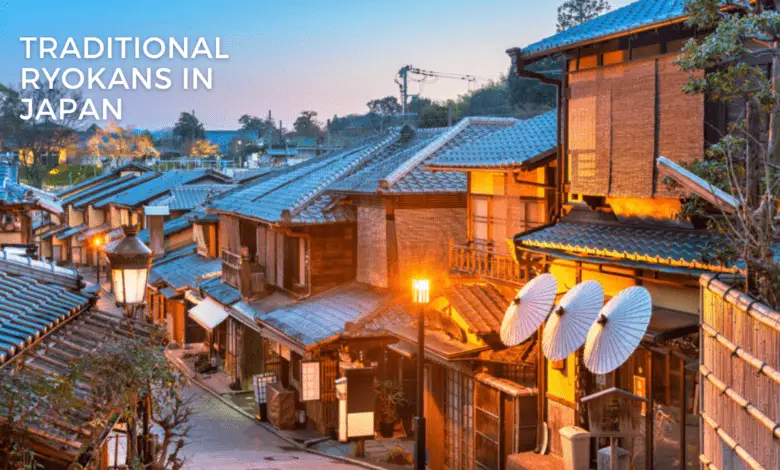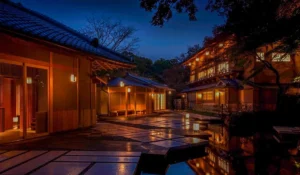🏯 Experiencing the Charm of Kyoto: Traditional Ryokans in Japan 🍵
Immerse Yourself in Japanese Hospitality and Culture

In the heart of Japan’s cultural capital, Kyoto, lies an enchanting world where time seems to stand still, and the essence of traditional Japanese hospitality is carefully preserved. This world is embodied in the serene and exquisite realm of Ryokans – traditional Japanese inns that offer travelers a unique opportunity to immerse themselves in the rich tapestry of Japanese culture.
In this article, we invite you to embark on a journey with us as we explore the essence of Kyoto through the lens of these charming abodes. “A Taste of the Orient: Staying in Traditional Ryokans in Kyoto, Japan” is your passport to discovering the authenticity, tranquility, and unparalleled experiences that await those who choose to embrace the ryokan way of life.
1. Historical Significance of Kyoto
Kyoto, often referred to as the heart of Japan, carries a profound historical legacy that continues to captivate travelers from around the world. This ancient city served as Japan’s capital for over a millennium, from 794 to 1868, during which it was known as Heian-kyo. This extended period of imperial rule and cultural flourishing left an indelible mark on Kyoto’s landscape, making it a repository of Japan’s rich history and traditions.
Kyoto is a living testament to Japan’s past, offering a glimpse into the country’s imperial era, samurai culture, and traditional arts. Visitors can explore well-preserved temples, shrines, and palaces, including UNESCO World Heritage Sites like Kinkaku-ji (the Golden Pavilion) and Fushimi Inari-taisha. The city’s meticulously designed gardens, ancient tea houses, and historic streets like Gion’s Hanamikoji Dori evoke a sense of stepping back in time.
Official site for Japanese Ryokens
Ryokans: The Ideal Accommodation for an Immersive Kyoto Experience
When seeking an immersive experience in Kyoto, there’s no better accommodation choice than a ryokan. These traditional Japanese inns offer more than just a place to sleep; they provide an authentic window into Kyoto’s cultural and historical essence.
- Architectural Time Travel: Ryokans are architectural marvels, often designed with meticulous attention to detail, showcasing the elegance of traditional Japanese craftsmanship. The use of tatami mats, sliding paper doors (fusuma), and minimalist decor creates an atmosphere reminiscent of Kyoto’s bygone eras.
- Cultural Immersion: Staying in a ryokan means immersing yourself in Japanese customs. From sleeping on futons laid out on tatami mats to savoring kaiseki (multi-course) meals, you’ll experience the refined traditions that have defined Kyoto for centuries.
- Zen-Like Serenity: Kyoto’s ryokans often feature beautiful gardens and tranquil settings, providing a serene escape from the bustling city. The harmony between nature and architecture enhances the overall sense of tranquility.
- Personalized Service: Ryokan staff offer exceptional hospitality, ensuring your every need is met. Many ryokans have onsen (hot spring) baths, where you can relax and rejuvenate while taking in the breathtaking surroundings.
- Location, Location, Location: Many ryokans are strategically situated in Kyoto’s historic districts, providing easy access to iconic landmarks, temples, and shrines. This proximity allows you to explore the city at a leisurely pace, absorbing its historical and cultural treasures.

Traditional Japanese Hospitality (Omotenashi) in Ryokans
Omotenashi, a cornerstone of Japanese culture, embodies the art of impeccable hospitality. This age-old practice goes beyond service; it’s about anticipating guests’ needs and providing an unparalleled experience. Nowhere is Omotenashi more brilliantly exemplified than in the welcoming embrace of Ryokans, traditional Japanese inns.
The Role of Omotenashi in Ryokans
- Warm Welcome: Upon entering a Ryokan, guests are greeted with a gracious bow and a warm, genuine welcome. The staff’s demeanor is unfailingly polite, setting the tone for a stay characterized by kindness and respect.
- Attentive Staff: Ryokan staff excel in the art of discretion, understanding when to offer assistance and when to allow guests their privacy. This intuitive sense ensures guests feel comfortable and well-cared for throughout their stay.
- Cultural Sensitivity: Ryokans understand the diverse needs of international guests and are adept at adapting their Omotenashi to suit different cultural backgrounds. They strive to make every guest feel respected and valued.
Examples of Exceptional Omotenashi in Ryokans
- Tea Ceremony: Upon arrival, guests are often ushered to their rooms where a traditional Japanese tea ceremony awaits. This ceremony symbolizes the initiation of hospitality, showcasing meticulous preparation and presentation of matcha tea and traditional sweets.
- Personalized Service: Ryokans excel in personalized service. They often remember individual guest preferences, such as dietary restrictions or preferred bathing times, and cater to them without needing to be reminded.
- Kaiseki Cuisine: Ryokans are known for their exquisite kaiseki dining experiences. The multi-course meals are culinary masterpieces, not just in taste but also in presentation. Each dish is crafted with precision, showcasing seasonal ingredients and regional specialties.
- Yukata Dressing: Many Ryokans offer the opportunity for guests to wear yukata, traditional Japanese robes. Staff members are experts in the art of dressing guests in these garments, adding to the immersive experience.
- Futon Service: In the evenings, staff discreetly transform the guest rooms, laying out futons for sleeping. This thoughtful gesture is done when guests are away to ensure maximum comfort and convenience.
- Onsen Etiquette: Staff in Ryokans guide guests on onsen etiquette, ensuring they can fully enjoy the therapeutic hot springs. They provide detailed instructions and sometimes even offer yukata or towels for the bathing experience.
- Farewell Ceremony: Just as the stay begins with a ceremony, it often concludes with a farewell ceremony where guests receive small parting gifts and warm wishes.
2. The Architecture and Aesthetics of Ryokans
Ryokans, traditional Japanese inns, are not just places to stay but immersive cultural experiences that offer a harmonious blend of architecture and aesthetics. These establishments are known for their distinctive design elements and serene atmospheres, which transport guests to a bygone era of Japanese elegance.
Unique Architectural Features of Ryokans
- Tatami Rooms: The hallmark of a Ryokan is its tatami mat rooms. These straw mats not only provide a comfortable surface for sitting and sleeping but also define the traditional ambiance of the space. Tatami rooms are often spacious and feature sliding paper doors (fusuma) that allow for flexibility in room configuration.
- Engawa: Many Ryokans have engawa, a type of veranda or corridor that encircles the building. These narrow wooden walkways provide stunning views of gardens or natural surroundings and serve as contemplative spaces for guests to relax and enjoy the scenery.
- Minimalist Design: Ryokans embrace minimalism in their design. Furniture is typically low to the ground, and the decor is simple and uncluttered, allowing guests to focus on the natural beauty and tranquility of their surroundings.
- Fusuma Art: The fusuma, or sliding paper doors, often feature intricate hand-painted artwork. These panels can be opened or closed to create different room configurations, and their artistic depictions often tell stories or showcase traditional motifs.
- Shoji Screens: Shoji screens are another integral part of Ryokan architecture. These translucent paper screens allow soft, diffused light to filter through, creating an ethereal atmosphere inside the rooms. They also add a sense of privacy while maintaining a connection to the outdoors.
Serene Atmosphere and Traditional Aesthetics
- Natural Elements: Ryokans are typically nestled in serene natural settings, whether it’s by a river, in a forest, or near a hot spring. The architecture is designed to blend seamlessly with the environment, incorporating elements like gardens, ponds, and rock formations.
- Zen Gardens: Many Ryokans feature meticulously manicured Zen gardens. These gardens are designed to inspire tranquility and contemplation, often incorporating elements like raked gravel, strategically placed stones, and carefully pruned trees.
- Seasonal Beauty: The aesthetics of Ryokans change with the seasons. Guests can enjoy cherry blossoms in spring, lush greenery in summer, vibrant foliage in autumn, and peaceful snowscapes in winter. The design and decor are adapted to complement the seasonal beauty outside.
- Cultural Artifacts: Traditional Japanese art and cultural artifacts adorn the interior spaces of Ryokans. Guests can often find calligraphy scrolls, ikebana (flower arrangements), and decorative ceramics that contribute to the overall aesthetic.
- Tea Rooms: Many Ryokans have dedicated tea rooms where guests can experience the traditional Japanese tea ceremony. These rooms are designed with precision and attention to detail, creating an authentic environment for this cultural ritual.
FAQs
Q: Can I stay in a Ryokan if I don’t speak Japanese?
A: Yes, many Ryokans have English-speaking staff who can assist you.
Q: Are Ryokans expensive?
A: Prices vary, but there are options to suit different budgets.
Q: Can I experience a traditional tea ceremony at a Ryokan?
A: Absolutely, many Ryokans offer tea ceremonies to guests.
Q: Is Wi-Fi available in Ryokans?
A: Most Ryokans offer Wi-Fi, but it’s a good idea to confirm when booking.
Q: What’s the best time to visit Kyoto and stay in a Ryokan?
A: Spring (cherry blossom season) and autumn (fall foliage) are popular, but each season has its charm.
Q: Do Ryokans accommodate dietary restrictions?
A: Yes, they often provide options for vegetarians and those with allergies.
Conclusion
As our journey through the enchanting world of Kyoto’s traditional Ryokans comes to an end, we hope you are left with a taste of the Orient that lingers on your palate long after you’ve departed. These venerable establishments offer not merely a place to rest your head, but a profound immersion into the very soul of Japan.
From the exquisite Kaiseki dining that teases your senses to the soothing embrace of Onsen waters, from the tranquility of Zen gardens to the warmth of Omotenashi, a stay in a Ryokan is an experience that transcends the ordinary and elevates your travels to a realm of cultural and spiritual enrichment.
So, whether you seek solace in the graceful elegance of tradition or the vibrant tapestry of modernity, a traditional Ryokan in Kyoto beckons, promising memories that will forever be etched in the annals of your travel diary. The path to Kyoto’s heart lies through its Ryokans, and we invite you to embark on this captivating journey of discovery. Arigatou gozaimasu – thank you for joining us on this extraordinary odyssey of “A Taste of the Orient: Staying in Traditional Ryokans in Kyoto, Japan.”
Up Next
🌴 Opulence in the Desert: Luxury Resorts in Dubai, UAE 🏨





Facebook Comments